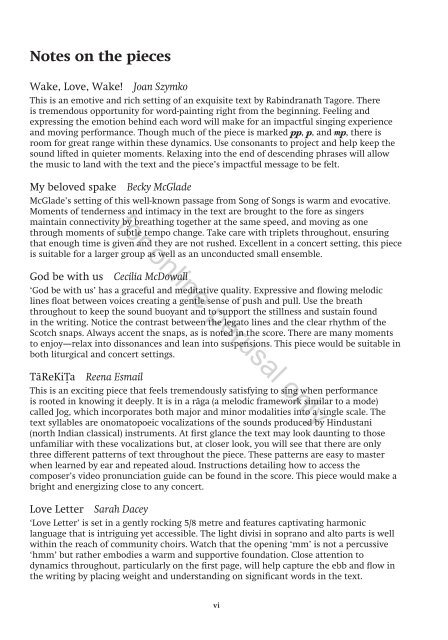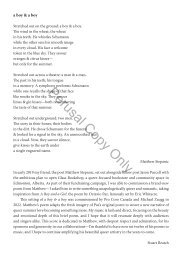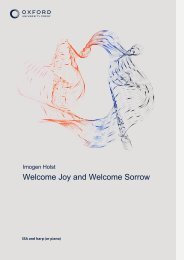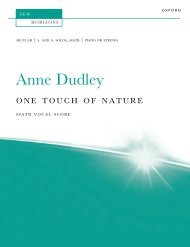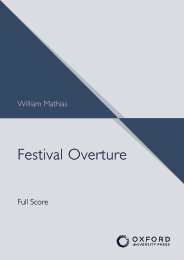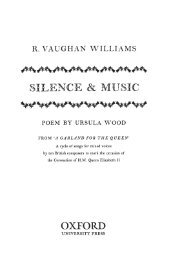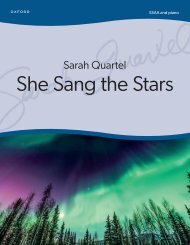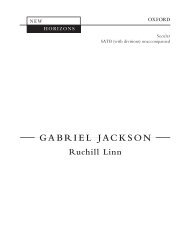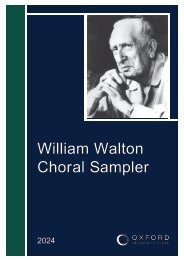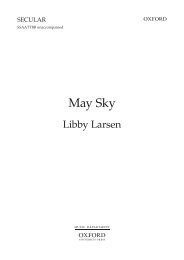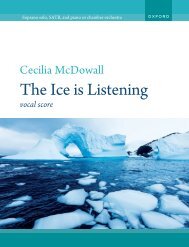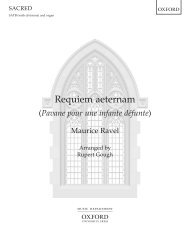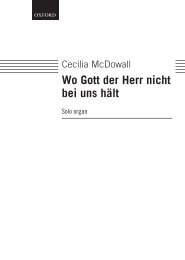Breath of Song
Breath of Song brings together ten exquisite works by contemporary women composers. Compiled and edited by Sarah Quartel, the collection features an eclectic mix of styles and colours, specially selected with modern concert programming in mind — from settings of hymn-like simplicity and a rich choral sound to works featuring theatrical body percussion and a fresh close-harmony style. Secular and sacred texts from across the centuries are given fresh life, and new words and sounds are introduced to the repertoire, including the onomatopoeic echoes of Hindustani classical instruments in Esmail's 'TaReKiTa' and the whistling of the wind and birds in Hawley's 'The Arrow and the Song'. Scored for unaccompanied mixed voices, this collection of ten compelling works is fresh, dynamic, and exciting — a long-awaited celebration of some of today's most inspirational voices in choral composition. Find out more: https://global.oup.com/academic/product/breath-of-song-9780193532021
Breath of Song brings together ten exquisite works by contemporary women composers. Compiled and edited by Sarah Quartel, the collection features an eclectic mix of styles and colours, specially selected with modern concert programming in mind — from settings of hymn-like simplicity and a rich choral sound to works featuring theatrical body percussion and a fresh close-harmony style. Secular and sacred texts from across the centuries are given fresh life, and new words and sounds are introduced to the repertoire, including the onomatopoeic echoes of Hindustani classical instruments in Esmail's 'TaReKiTa' and the whistling of the wind and birds in Hawley's 'The Arrow and the Song'. Scored for unaccompanied mixed voices, this collection of ten compelling works is fresh, dynamic, and exciting — a long-awaited celebration of some of today's most inspirational voices in choral composition.
Find out more: https://global.oup.com/academic/product/breath-of-song-9780193532021
Create successful ePaper yourself
Turn your PDF publications into a flip-book with our unique Google optimized e-Paper software.
Notes on the pieces<br />
Wake, Love, Wake! Joan Szymko<br />
This is an emotive and rich setting <strong>of</strong> an exquisite text by Rabindranath Tagore. There<br />
is tremendous opportunity for word-painting right from the beginning. Feeling and<br />
expressing the emotion behind each word will make for an impactful singing experience<br />
and moving performance. Though much <strong>of</strong> the piece is marked pp, p, and mp, there is<br />
room for great range within these dynamics. Use consonants to project and help keep the<br />
sound lifted in quieter moments. Relaxing into the end <strong>of</strong> descending phrases will allow<br />
the music to land with the text and the piece’s impactful message to be felt.<br />
My beloved spake Becky McGlade<br />
McGlade’s setting <strong>of</strong> this well-known passage from <strong>Song</strong> <strong>of</strong> <strong>Song</strong>s is warm and evocative.<br />
Moments <strong>of</strong> tenderness and intimacy in the text are brought to the fore as singers<br />
maintain connectivity by breathing together at the same speed, and moving as one<br />
through moments <strong>of</strong> subtle tempo change. Take care with triplets throughout, ensuring<br />
that enough time is given and they are not rushed. Excellent in a concert setting, this piece<br />
is suitable for a larger group as well as an unconducted small ensemble.<br />
for online perusal only<br />
God be with us Cecilia McDowall<br />
‘God be with us’ has a graceful and meditative quality. Expressive and flowing melodic<br />
lines float between voices creating a gentle sense <strong>of</strong> push and pull. Use the breath<br />
throughout to keep the sound buoyant and to support the stillness and sustain found<br />
in the writing. Notice the contrast between the legato lines and the clear rhythm <strong>of</strong> the<br />
Scotch snaps. Always accent the snaps, as is noted in the score. There are many moments<br />
to enjoy—relax into dissonances and lean into suspensions. This piece would be suitable in<br />
both liturgical and concert settings.<br />
TāReKiṬa Reena Esmail<br />
This is an exciting piece that feels tremendously satisfying to sing when performance<br />
is rooted in knowing it deeply. It is in a rāga (a melodic framework similar to a mode)<br />
called Jog, which incorporates both major and minor modalities into a single scale. The<br />
text syllables are onomatopoeic vocalizations <strong>of</strong> the sounds produced by Hindustani<br />
(north Indian classical) instruments. At first glance the text may look daunting to those<br />
unfamiliar with these vocalizations but, at closer look, you will see that there are only<br />
three different patterns <strong>of</strong> text throughout the piece. These patterns are easy to master<br />
when learned by ear and repeated aloud. Instructions detailing how to access the<br />
composer’s video pronunciation guide can be found in the score. This piece would make a<br />
bright and energizing close to any concert.<br />
Love Letter Sarah Dacey<br />
‘Love Letter’ is set in a gently rocking 5/8 metre and features captivating harmonic<br />
language that is intriguing yet accessible. The light divisi in soprano and alto parts is well<br />
within the reach <strong>of</strong> community choirs. Watch that the opening ‘mm’ is not a percussive<br />
‘hmm’ but rather embodies a warm and supportive foundation. Close attention to<br />
dynamics throughout, particularly on the first page, will help capture the ebb and flow in<br />
the writing by placing weight and understanding on significant words in the text.<br />
vi


